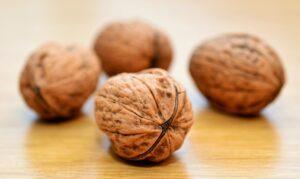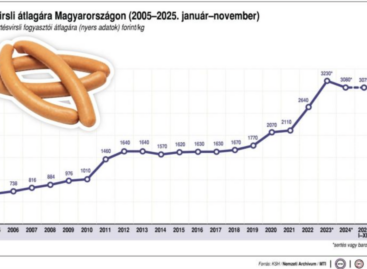A more balanced nut crop is expected this year than before
Farmers on domestic walnut plantations are confident of a good harvest this year. After last year’s drought, a significant improvement in the quantity and quality of the harvest is expected. However, according to the National Chamber of Agriculture and the Hungarian Fruit and Vegetable Association (FruitVeB), market conditions are not so favorable. It is difficult for domestic goods to compete with overseas walnuts. In order to increase the efficiency of cultivation, the development of cultivation technology and the modernization of cultivation systems are essential.

(Photo: Pixabay)
The domestic walnut farmers are optimistic, after last year’s drought, a better than average harvest is expected this year. According to the overview of the National Chamber of Agriculture and the Hungarian Fruit and Vegetable Association (FruitVeB), overall, an excellent harvest in terms of quantity and quality can be expected this year, although last year’s extreme drought is felt in several growing areas, which due to the weaker flowering, is below average, or even more than that in some places. also takes shape in a weaker crop.
In Somogy – where walnuts are grown on around 618 hectares – harvesting has already begun
According to the first experiences, the fruit size, internal content (full cloves) and coloring (nice light brown) can also be said to be good. However, the heavy rain also caused plant protection problems. In Poland, they expect a medium crop with good size and quality. The nut shell borer did not cause any problems in large-scale production conditions, but bacterial infections had to be dealt with, in which the ever-shrinking range of agents did not help the producers’ work either.
Almost half of the 9,408-hectare walnut growing area in Hungary is located in Szabolcs (4,489 ha)
The spring frosts spared the plantations in Szabolcs, and the walnut borer did not cause damage to the commodity-producing plantations either. Bacterial diseases were present due to the high rainfall, but they proved to be preventable with disciplined plant protection. Fruit size is developing favorably, especially after last year’s smaller crop.
There are a total of 277 ha of walnut plantations in the county of Vas, and the spring frosts did not cause any problems there this year either
Due to the rainy spring and summer, the fruits were able to ripen nicely until the shell was formed. So, in addition to the fact that there are a lot of nuts on the trees, their size can also be said to be large. Since they were able to overcome bacterial infections with organized plant protection in this county, it is quite certain that an excellent harvest can be expected in large-scale production conditions. The situation is not so bright in scattered nuts, due to the high rainfall, Xanthomonas and the nut borer blackened the nuts.
While farmers can be satisfied with this year’s harvest, market conditions are far from favorable
Ukrainian and Moldovan walnut kernels of unknown origin and questionable quality are a serious problem for domestic producers. Foreign, clearly worse and more uneven quality, sun-dried nut casings, potentially containing chemical residues, seriously depress domestic nut prices every year. The producer price of raw in-shell walnuts and dried, graded in-shell walnuts has fallen sharply in the past two years. At the same time, achieving quality-based distinctiveness could significantly improve the recognition of the domestic product and build consumer confidence. In addition to nut guts, consumers can also find shelled nuts. Stone fruit can be found on the counters of large supermarket chains almost all year round. Chilean and Australian shelled walnuts have been arriving in European supermarket chains since May, and Californian walnuts add color to the range at the end of November, but Chinese items also appear in European retail chains from time to time. According to NAK and FruitVeB, the shrinking of the European markets is a serious threat due to the appearance of overseas competitors who, moreover, have developed their European sales very quickly in the last 10-15 years. While European chains used to have tenders that specifically envisaged the purchase of Hungarian walnuts – partly because of their good quality and partly because of their favorable seasonality -, however, there is no trace of this among retailers today. Chilean and Australian walnuts displaced the Hungarian crop from supermarket chains. The reason for this is that Hungarian walnuts lost their competitiveness against Chilean and Australian walnuts, which also arrived early on the market. And this is true not only for foreign stores, but also for chains operating in our country.
In order to improve our competitiveness, the domestic large-scale production averages should be significantly increased to 4 tons per hectare within a short period of time
In order to increase the efficiency of cultivation, it is essential to develop the cultivation technology, to modernize the cultivation system, and above all to create a more manageable crown shape, with which the problems of plant protection in the otherwise typical dense crown can be solved without problems. The smaller crown shape and regular pruning also make the renewal of the fruiting parts continuous, with which baldness, which is also characteristic of walnuts, and the aging of the fruiting parts can be reduced. Producers consider the subsidies for plantation planting, irrigation and the purchase of machinery very useful, which in previous years have greatly helped farmers intending to produce at a high level in the modernization of plantations, as well as in the mechanization of postharvest and product preparation operations. NAK and the National Food Chain Safety Office are also trying to improve the efficiency of production with a presentation of walnut varieties. The event held in Pölöske – Aliz major in Zala County discussed, among other things, the rules of drone plant protection, the operational experience of walnut plant protection, pruning technologies and the walnut market situation.
NAK/FruitWeb
Related news
NAK: it’s worth buying Hungarian sausages on New Year’s Eve too
🎧 Hallgasd a cikket: Lejátszás Szünet Folytatás Leállítás Nyelv: Auto…
Read more >Authorities seize expired gyro meat in Budapest: inspections tighten in the street food sector
🎧 Hallgasd a cikket: Lejátszás Szünet Folytatás Leállítás Nyelv: Auto…
Read more >This year, 10 percent more new wine was produced than last year
🎧 Hallgasd a cikket: Lejátszás Szünet Folytatás Leállítás Nyelv: Auto…
Read more >Related news
New Year’s Eve: shortened opening hours in stores – general store closure on January 1
🎧 Hallgasd a cikket: Lejátszás Szünet Folytatás Leállítás Nyelv: Auto…
Read more >Tejföl is only a name for live flora: new categories for sour dairy products will be introduced from 2026
🎧 Hallgasd a cikket: Lejátszás Szünet Folytatás Leállítás Nyelv: Auto…
Read more >Sausage prices before New Year’s Eve: cheap entry, expensive premium – how big is the gap on the shelves?
🎧 Hallgasd a cikket: Lejátszás Szünet Folytatás Leállítás Nyelv: Auto…
Read more >






